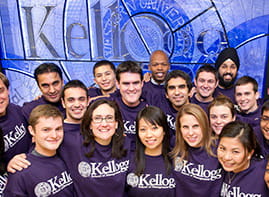In-store mobile shoppers are likely to be the biggest spenders this holiday season, Kellogg researchers find
11/16/2011 - The rise of online and mobile shopping is shifting Cyber Monday earlier.
Thanks to smartphones, “Cyber Friday” has emerged as new territory for retailers to attract consumers. According to the Kellogg Shopper Index, one in four consumers (26 percent) responded that they frequently or always use a mobile device to compare prices while shopping in a store. Nearly two-thirds (64 percent) said they already do so at least occasionally.
Unlike other surveys and indices, the Kellogg Shopper Index explores how underlying consumer psychology and changes in household finance affect consumer shopping behaviors and trends. The survey is designed by
Eric Anderson, the Hartmarx Professor of Marketing;
Derek Rucker, associate professor of marketing; and Richard Wilson, a clinical associate professor of marketing. Anderson and Rucker are directors of the Kellogg Center for Global Marketing Practice. Wilson is associate director of the center.
“For holiday shoppers, the kickoff routine has typically meant battling crowds the night of Thanksgiving until the following day, then resuming their retail quest on Monday by online deal-surfing from the office,” says Wilson. “However, technology is quickly making new norms possible. Pervasive digital data plans and in-store wi-fi are enabling shoppers to do it all at once — combine offline and online excursions together.”
In-store mobile shoppers likelier to purchase luxury gifts
The Kellogg Shopper Index finds that today’s in-store mobile shopper is a big spender on the hunt for premium gifts and prefers to purchase items in a physical store. However, in-store shoppers are more likely to compare prices on their mobile devices in search of the best deal. The survey finds these traits among the profile of an in-store mobile shopper:
- Enviable demographics: highly educated, high income and generally satisfied with life.
- More likely to be men: 12 percent of men say they always use mobile devices to check prices while shopping in stores, versus 5 percent of women.
- Not the youngest shoppers: 10 percent of adults 31 to 35 years old are always mobile price shoppers versus 7 percent of adults 21 to 25 years old.
The Kellogg Shopper Index also reveals that consumers still like browsing, learning, touching, comparing and shopping at stores. This attitude holds true for people who always use a phone to price-check while shopping in a store and who are planning to purchase premium and luxury items.
Relative to participants who say they never use mobile devices to price check in-store, mobile shoppers are:
- Self-focused: twice as likely to be buying for themselves.
- Store devotees: more likely to enjoy local store browsing versus shopping online.
- Strong multi-channel buyers: still spend about half their dollars in stores.
- Luxury-oriented shoppers: spend four to five times as much of their budget on luxury goods as do people who never use their phones to shop in-store.
- Social shoppers: more likely to use social media and search engines, and to browse online before shopping in stores.
- The heaviest shoppers: spend the most time shopping overall — both online and in stores. These shoppers are expected to show the greatest increase in household spending compared to last year.
Anderson believes an important takeaway is the robust multi-channel behaviors these heavy mobile shoppers exhibit. “For mobile shoppers, it’s not about offline versus online. It’s about taking advantage of all the channels, whether it’s stores, Internet, mobile or social media,” he says.
“We also see that heavy mobile shoppers in our survey are much more oriented to delighting gift recipients versus avoiding their disappointment,” Rucker adds. “This psychological mindset, an area of consumer behavioral research called regulatory focus, will have significant implications for retail models that win and lose with mobile marketers.”
As mobile shopping booms, Wilson points out that there is a challenge ahead for traditional store-based retailers but also some hope. “The danger for stores is, of course, that they end up as showrooms for Web competitors like Amazon, but it doesn’t have to turn out that way,” he says. “As in any arms race, victory goes to those who best adapt to the new game.”
ABOUT THE SURVEY
Supported by the Kellogg Center for Global Marketing Practice, the Kellogg Shopper Index is a national survey that collects data from an online panel of more than 1,400 participants. The purpose of the index is to develop a 360-degree perspective of consumer spending habits that explores what and how people plan to purchase items or services, as well as the underlying psychological and financial drivers of their spending behavior. Based on key findings, the index offers fresh insights and practical applications for businesses and marketing practitioners. The Kellogg Shopper Index is compliant with the Institutional Review Board (IRB) standards. For more information visit the Kellogg Center for Global Marketing Practice.
Media inquiries about this survey may be directed to Aaron Mays at
a-mays@kellogg.northwestern.edu.






